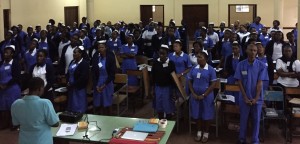Marcus Wootton BSc (Hons) BN (Hons) RN (A) RN (C)Senior Lecturer at London South Bank offers an insightful snapshot of nursing in Uganda
The learning day in Uganda starts in a large lecture theatre; the room is dimly lit with only two of the fourteen strip lights functioning, it isn’t cold but the sky is ashen grey and it’s raining heavily.
 Water pours through a broken window and trickles across the floor. Much of the clinical information comes from textbooks, which are shared amongst the students and the lecture notes copied by rote. Internet access is limited, with no real opportunities for online learning. Blackboards with chalk stubs are the mainstay of presentation. This is the reality of health education in Uganda
Water pours through a broken window and trickles across the floor. Much of the clinical information comes from textbooks, which are shared amongst the students and the lecture notes copied by rote. Internet access is limited, with no real opportunities for online learning. Blackboards with chalk stubs are the mainstay of presentation. This is the reality of health education in Uganda
Uganda has 1.3 nurses & midwives for every 1000 people, compared to the UK where this figure is more than 10 per 1000.1 Nurses & midwives work in a health system trying and coping with a twin issues of an onslaught of rapidly increasing demand with proportionally static funding,2 and disease burden that includes diseases that have long since been consigned to history in the UK. In one example of many; every one of the students in the lecture theatre had cared for at least one patient experiencing the painful contortions of tetanus. More broad impacts on health relate to UNICEF estimations that a quarter of Uganda’s children live in extreme poverty.3
Whilst the situation improved in the six months since I was last in Kampala the health economy still faces huge challenges. Health staff can go for months without being paid and they battle through a lack of consistent medical supplies. The children’s ward and high dependency area had no oxygen supply when I visited. Staff described having to make unimaginable life and death decisions regarding which children they were most likely to save based on the finite resources available. As part of a small team working for the charity Help 4 Hurting Children. I helped deliver three children’s training courses to 400 nurses and midwives both students and qualified staff. This represents more than 10 per cent of Uganda’s total nursing and midwifery workforce in a country of 37 million.4
So why is it that I’m sitting 38,000 feet above ground on my way home feeling hopeful? The greatest asset of any system is its people and, based on those I met, I have no doubt that Uganda’s nurses and midwifes can drive change and make huge improvement. Put simply, they were remarkable and awe inspiring individuals and teams. Cursed with the expert clinical knowledge to know what treatment options should be available and, for a myriad of reasons aren’t, they innovate and improvise daily. With so much recent focus on filling NHS vacancies, with staff from countries who dearly need them, we should maybe consider more closely the implications of our asset stripping on nations like Uganda who are far poorer than ourselves
If (and it is a very big ‘if’) Uganda and the developed nations can reduce the brain drain that pushes and pulls so many nurses, doctors, dentists and other skilled professionals towards the financial rewards of more affluent settings, based on my experience at least, there is cause for cautious optimism.
Further reading
World Health Organisation (2014) accessed from http://www.apps.who.int/globalatlas/dataQuery/default.asp. Accessed on 26/11/2015
Africa Health Workforce Observatory (2009) ‘ Human Resources for Health Country Profile – Uganda’. Available from http://www.who.int/workforcealliance/knowledge/resources/hrh_profile_uganda/en/
UNICEF (2014) accessed from http://www.unicef.org/infobycountry/uganda_statistics.html Accessed on 26/11/2015
World bank (2014) available from http://data.worldbank.org/country/uganda
Accessed on 26/11/2015